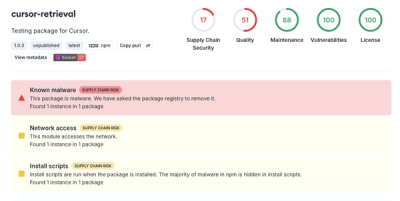
Security News
The Risks of Misguided Research in Supply Chain Security
Snyk's use of malicious npm packages for research raises ethical concerns, highlighting risks in public deployment, data exfiltration, and unauthorized testing.
This package provides authentication module with interceptor
npm install ngx-auth --save
For older versions of angular see Older Versions section.
Full example you can find in the example folder.
Authentication modules provides ability to attach authentication token automatically to the headers (through http interceptors), refresh token functionality, guards for protected or public pages and more.
AuthService interface to implement it with your custom Authentication service, e.g.:import { AuthService } from 'ngx-auth';
@Injectable()
export class AuthenticationService implements AuthService {
private interruptedUrl: string;
constructor(private http: Http) {}
isAuthorized() {
const isAuthorized = !!sessionStorage.getItem('accessToken');
return of(isAuthorized);
}
getAccessToken() {
const accessToken = sessionStorage.getItem('accessToken');
return of(accessToken);
}
refreshToken(): Observable<any> {
const refreshToken = sessionStorage.getItem('refreshToken');
return this.http
.post('http://localhost:3001/refresh-token', { refreshToken })
.catch(() => this.logout())
}
refreshShouldHappen(response: HttpErrorResponse) {
return response.status === 401;
}
verifyRefreshToken(req: HttpRequest<any>) {
return req.url.endsWith('refresh-token');
}
skipRequest(req: HttpRequest<any>) {
return req.url.endsWith('third-party-request');
}
getInterruptedUrl() {
return this.interruptedUrl;
}
setInterruptedUrl(url: string) {
this.interruptedUrl = url;
}
}
publicGuard for public routes and protectedGuard for protected respectively, e.g.:const routes: Routes = [
{
path: '',
component: PublicComponent,
canActivate: [publicGuard],
children: [/*...*/],
},
{
path: '',
component: ProtectedComponent,
canActivate: [protectedGuard],
children: [/*...*/],
}
];
AuthenticationModule and provide important providers and imports, e.g.:import { NgModule } from '@angular/core';
import { AuthModule, AUTH_SERVICE, PUBLIC_FALLBACK_PAGE_URI, PROTECTED_FALLBACK_PAGE_URI } from 'ngx-auth';
import { AuthenticationService } from './authentication.service';
@NgModule({
imports: [ AuthModule ],
providers: [
{ provide: PROTECTED_FALLBACK_PAGE_URI, useValue: '/' },
{ provide: PUBLIC_FALLBACK_PAGE_URI, useValue: '/login' },
{ provide: AUTH_SERVICE, useClass: AuthenticationService }
]
})
export class AuthenticationModule { }
where,
PROTECTED_FALLBACK_PAGE_URI - main protected page to be redirected to, in case if user will reach public route, that is protected
by publicGuard and will be authenticated
PUBLIC_FALLBACK_PAGE_URI - main public page to be redirected to, in case if user will reach protected route, that is protected
by protectedGuard and won't be authenticated
AUTH_SERVICE - Authentication service token providers
AuthenticationModule in your AppModuleBy default, requests are intercepted and a { Authorization: 'Bearer ${token}'} header is injected. To customize this behavior, implement the getHeaders method on your AuthenticationService
The AuthService has an optional method setInterruptedUrl which saves the URL that was requested before the user is redirected to the login page. This property can be used in order to redirect the user to the originally requested page after he logs in. E.g. in your login.component.ts (check also AuthService implementation above):
@Component({
selector: 'app-login',
templateUrl: './login.component.html'
})
export class LoginComponent {
login() {
this.authService.login()
.subscribe(() =>
this.router.navigateByUrl(this.authService.getInterruptedUrl())
);
}
}
For angular 7-15, use version 5.4.0
npm install ngx-auth@5.4.0 --save
For angular 6, use version 4.1.0
npm install ngx-auth@4.1.0 --save
For angular 5, use version 3.1.0
npm install ngx-auth@3.1.0 --save
For angular 4, use version 2.2.0
npm install ngx-auth@2.2.0 --save
FAQs
Angular 16+ Authentication module
We found that ngx-auth demonstrated a not healthy version release cadence and project activity because the last version was released a year ago. It has 1 open source maintainer collaborating on the project.
Did you know?

Socket for GitHub automatically highlights issues in each pull request and monitors the health of all your open source dependencies. Discover the contents of your packages and block harmful activity before you install or update your dependencies.

Security News
Snyk's use of malicious npm packages for research raises ethical concerns, highlighting risks in public deployment, data exfiltration, and unauthorized testing.

Research
Security News
Socket researchers found several malicious npm packages typosquatting Chalk and Chokidar, targeting Node.js developers with kill switches and data theft.

Security News
pnpm 10 blocks lifecycle scripts by default to improve security, addressing supply chain attack risks but sparking debate over compatibility and workflow changes.